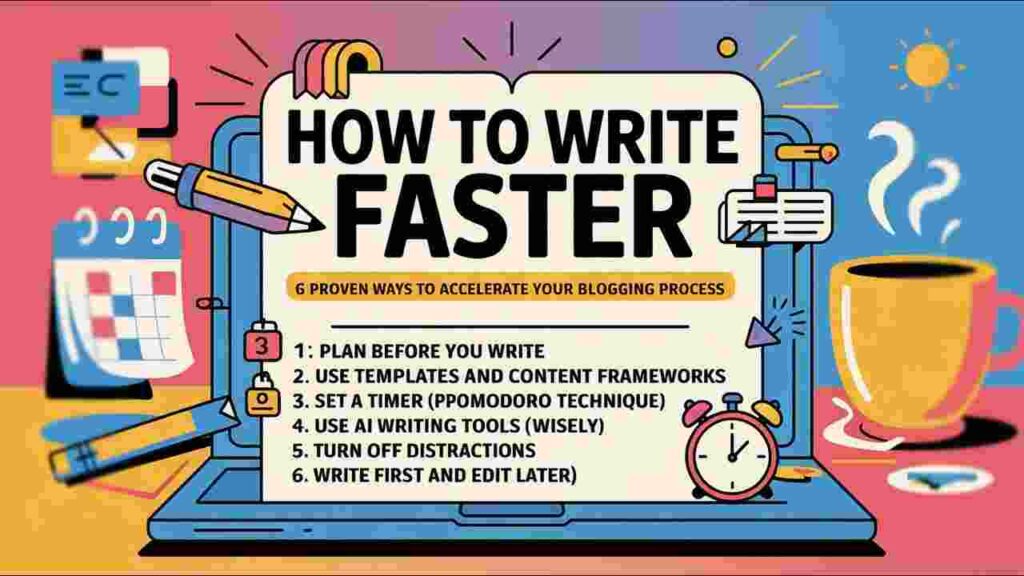Writing great blog content takes time, but what if you could speed up your process without sacrificing quality?
Whether you’re a full-time blogger, content creator, or just trying to grow your side hustle, learning how to write faster can save hours of your time and boost your productivity.
In this guide, we’ll walk you through six practical, easy-to-follow techniques to help you write faster and better — without the burnout.
Why Writing Faster Matters
Before we dive into the how-to, let’s quickly address the “why.” Blogging isn’t just about throwing words onto a page — it’s about sharing valuable insights with your audience, ranking well in search engines, and staying consistent.
But let’s face it: staring at a blank screen for hours can be frustrating. The faster you write, the more content you can publish, and the better your chances of success.
How to Write Faster: 6 Proven Ways to Accelerate Your Blogging Process
Time is money — and when you know how to write faster, you can:
- Meet deadlines easily
- Maintain a regular posting schedule
- Spend more time promoting your content
- Reduce stress and overwhelm
Now let’s jump into the good stuff!
1. Plan Before You Write
One of the biggest mistakes new bloggers make is starting without a plan. When you sit down to write without knowing where you’re going, it’s like trying to drive blindfolded
Here’s how to plan your blog post effectively:
- Choose a clear topic: Focus on one main idea to avoid getting lost.
- Do your research: Gather data, quotes, or examples in advance.
- Outline your content: Create a structure with headings, subheadings, and bullet points.
Having a roadmap makes writing feel more like connecting the dots rather than inventing something from scratch.
Bonus Tip: Use tools like Trello, Notion, or Google Docs to organize your blog outlines and research.
2. Use Templates and Content Frameworks
Why reinvent the wheel every time you write? Professional bloggers and copywriters use content templates for a reason — they work.
Popular blogging frameworks include:
- How-to guides (like this one!)
- Listicles (e.g., 10 Tips to Grow Your Blog)
- Case studies
- Step-by-step tutorials
- Comparison articles
These frameworks provide a skeleton to follow, helping you stay focused and organized. Once you know the format, you’ll naturally write faster.
3. Set a Timer (Pomodoro Technique)
Sometimes, a little pressure is all you need to get moving. The Pomodoro Technique — a time management method that breaks work into short intervals — can work wonders.
Here’s how it works:
- Set a timer for 25 minutes (one Pomodoro)
- Write without stopping — no edits, no distractions
- Take a 5-minute break
- Repeat for 3–4 cycles, then take a longer break
This method trains your brain to focus in short bursts, making it easier to get into the writing zone. Many writers find they can double their output using Pomodoro sprints.
4. Use AI Writing Tools (Wisely)
Artificial Intelligence can be a game-changer when used correctly. While it shouldn’t replace your creativity, AI can speed up brainstorming, outlining, and even rough drafting.
Popular AI tools include:
- ChatGPT
- Jasper AI
- Grammarly (for editing)
- Copy.ai
Use AI to:
- Generate blog post ideas
- Create article outlines
- Rewrite paragraphs for clarity
- Improve SEO elements
But always remember: your personal voice matters. Use AI as an assistant, not a ghostwriter.
5. Turn Off Distractions
Notifications, social media, email alerts and your phone buzzing every five minutes are productivity killers. All these interruptions can drag out your writing session and kill your flow. Build a distraction-free zone to write faster and deeper.
Here’s how to create a distraction-free writing environment:
- Put your phone on airplane mode or in another room
- Use browser blockers (like StayFocusd or Freedom)l
- Write in full-screen mode
- Close all unnecessary tabs
Protect your creative space like a lion guards its territory. The fewer distractions you have, the faster (and better) you’ll write.
6. Write First and Edit Later
Write first and eidit later. This is a golden rule for anyone learning how to write faster.
When you try to write and edit at the same time, your brain gets overwhelmed. Writing is a creative process; editing is analytical. Mixing the two slows you down.
Try this approach instead
- Get your first draft out as quickly as possible — imperfections and all
- Focus on getting your ideas down
- Go back later to polish, correct grammar, and refine
Remember: You can’t edit a blank page. But you can shape a rough draft into something great.
Bonus Tips to Supercharge Your Writing Speed
Still looking for an extra boost? Try these bonus hacks:
- Batch similar tasks: Do all your research at once, then write, then edit
- Write at your peak time: Identify when you’re most focused (morning, afternoon, evening)
- Use speech-to-text tools: If you’re faster at talking than typing, this can be a huge time-saver
- Keep a swipe file: Save headlines, intros, or templates you can reuse or adapt later
Final Thoughts: Mastering How to Write Faster
Writing faster doesn’t mean cutting corners — it means working smarter. By planning ahead, removing distractions, using smart tools, and embracing the art of rough drafts, you’ll not only save time but also create more valuable content for your readers.
The truth is, the more you write, the faster you get. Just like any other skill, speed comes with practice and consistency. So, the next time you sit down to write a blog post, remember these tips, apply them, and watch your content creation game level up.
Ready to Write Faster and Smarter?
Imagine being able to hit “publish” in half the time it used to take you. With the six strategies we covered in this guide, you’re now equipped to tackle writer’s block, boost your productivity, and grow your blog like never before.
If you found this helpful, share it with a fellow blogger or content creator. And hey — don’t forget to bookmark it for your next writing session!
Now go out there and write like the wind.


